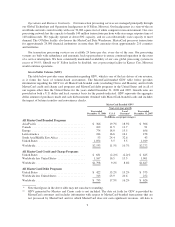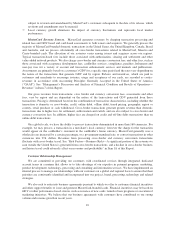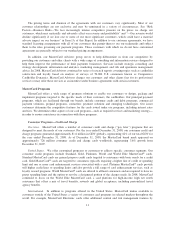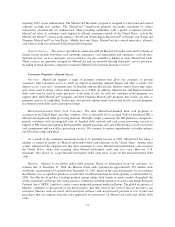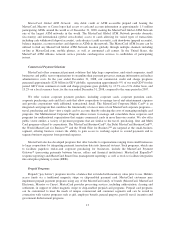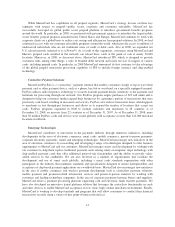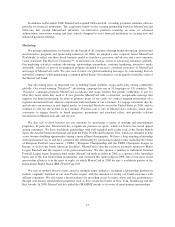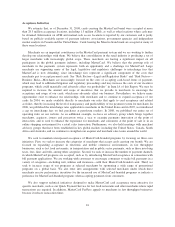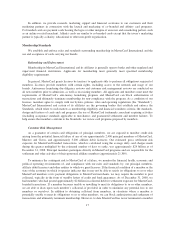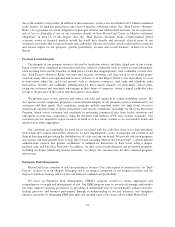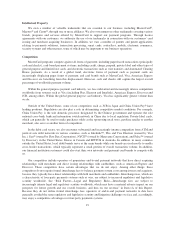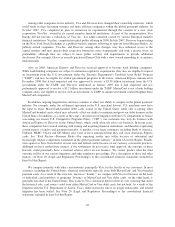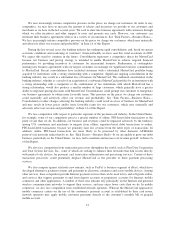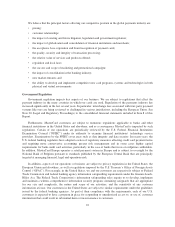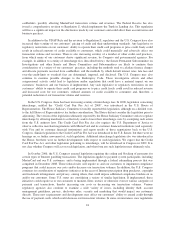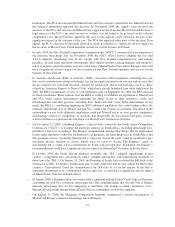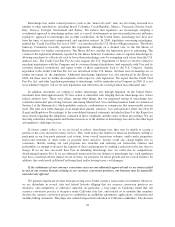MasterCard 2008 Annual Report Download - page 29
Download and view the complete annual report
Please find page 29 of the 2008 MasterCard annual report below. You can navigate through the pages in the report by either clicking on the pages listed below, or by using the keyword search tool below to find specific information within the annual report.Intellectual Property
We own a number of valuable trademarks that are essential to our business, including MasterCard®,
Maestro®and Cirrus®, through one or more affiliates. We also own numerous other trademarks covering various
brands, programs and services offered by MasterCard to support our payment programs. Through license
agreements with our customers, we authorize the use of our trademarks in connection with our customers’ card
issuing and merchant acquiring businesses. In addition, we own a number of patents and patent applications
relating to payments solutions, transaction processing, smart cards, contactless, mobile, electronic commerce,
security systems and other matters, some of which may be important to our business operations.
Competition
MasterCard programs compete against all forms of payment, including paper-based transactions (principally
cash and checks), card-based payment systems, including credit, charge, prepaid, private-label and other types of
general purpose and limited use cards, and electronic transactions such as wire transfers and Automated Clearing
House payments. As a result of a global trend, electronic forms of payment such as payment cards are
increasingly displacing paper forms of payment, and card brands such as MasterCard, Visa, American Express
and Discover are benefiting from this displacement. However, cash and checks still capture the largest overall
percentage of worldwide payment volume.
Within the general purpose payment card industry, we face substantial and increasingly intense competition
worldwide from systems such as Visa (including Plus, Electron and Interlink), American Express, Discover and
JCB, among others. Within the global general purpose card industry, Visa has significantly greater volume than
we do.
Outside of the United States, some of our competitors such as JCB in Japan and China Union Pay®have
leading positions. Regulation can also play a role in determining competitive market conditions. For example,
China Union Pay is the sole domestic processor designated by the Chinese government and operates the sole
national cross-bank bankcard information switch network in China due to local regulation. Private-label cards,
which can generally be used to make purchases solely at the sponsoring retail store, gasoline retailer or another
merchant, also serve as another form of competition.
In the debit card sector, we also encounter substantial and increasingly intense competition from ATM and
point-of-sale debit networks in various countries, such as Interlink™, Plus and Visa Electron (owned by Visa
Inc.), Star®(owned by First Data Corporation), NYCE®(owned by Metavante Corporation), and Pulse™ (owned
by Discover), in the United States, Interac in Canada and EFTPOS in Australia. In addition, in many countries
outside the United States, local debit brands serve as the main brands while our brands are used mostly to enable
cross-border transactions, which typically represent a small portion of overall transaction volume. In addition,
our financial institution customers could also start their own networks and payment card brands to compete with
us.
Our competitors include operators of proprietary end-to-end payment networks that have direct acquiring
relationships with merchants and direct issuing relationships with cardholders, such as American Express and
Discover. These competitors have certain advantages that we do not enjoy. Among other things, these
competitors do not require formal interchange fees to balance payment system costs among issuers and acquirers,
because they typically have direct relationships with both merchants and cardholders. Interchange fees, which are
a characteristic of four-party payments systems such as ours, are subject to increased regulatory and legislative
scrutiny worldwide. See “Risk Factors—Legal and Regulatory Risks—Interchange fees are subject to
increasingly intense legal and regulatory scrutiny worldwide, which may have a material adverse impact on our
prospects for future growth and our overall business, and thus on our revenue” in Item 1A of this Report.
Because they do not utilize formal interchange fees, operators of end-to-end payment networks to date have
generally avoided the same regulatory and legislative scrutiny and litigation challenges we face and, accordingly,
may enjoy a competitive advantage over four-party payments systems.
19


